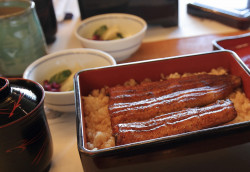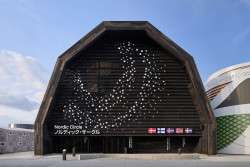
February 4, 2010
Eco Edo
A new book delves into Japan’s past for tips on how to save the planet
By Metropolis
Originally published on metropolis.co.jp on February 2010

Illustrations © Azby Brown
People often emphasize the importance of studying history for what our ancestors got wrong. As Spanish philosopher George Santayana pronounced, “Those who cannot remember their past are condemned to repeat it.” But what of the things that our ancestors got right? In his illuminating new book Just Enough: Lessons in Living Green from Traditional Japan, Azby Brown looks back to the Edo period for answers to 21st century environmental problems. Surveying the lifestyles of rural farmers, Edo residents and samurai, he finds countless examples of sustainable practices, in everything from architecture to agriculture, diet to waste disposal. The following excerpts offer a taste of this remarkable work.

“Japanese society once faced the prospect of collapse due to environmental degradation, and the fact that it did not is what makes it such an instructive example. Japan entered the Edo period in 1603 facing extreme difficulties in obtaining building timber, suffering erosion and watershed damage due to having clear-cut so many of its mountains for lumber, and virtually unable to expand agricultural production to the degree necessary to feed a growing population. The needs of the urban population, particularly those of the capital city of Edo, but also those of Osaka, Nagoya, and numerous other growing cities, conflicted with those of the rural areas, and the life of farmers was made all the more difficult by their legal obligation to surrender one-third or more of their harvest to support the warrior classes.
At the start of the Edo period, nearly all of the potentially arable land had already been opened to cultivation and was feeding, just barely, a population of about twelve million. Agricultural land in many areas was showing signs of exhaustion and degradation, and output was declining. All the more remarkable, then, that two hundred years later the same land was supporting thirty million people—two and a half times the population—with little sign of environmental degradation.

More than anything else, this success was due to a pervasive mentality that propelled all of the other mechanisms of improvement. This mentality drew on an understanding of the functioning and inherent limits of natural systems. It encouraged humility, considered waste taboo, suggested cooperative solutions, and found meaning and satisfaction in a beautiful life in which the individual took just enough from the world and not more.
Though Japan today must be credited with admirable efforts in reducing its pollution, improving the efficiency with which it uses energy, and maintaining its forest cover through regenerative forestry, and though it has high rates of public transportation use, strong standards for recycling, and excellent designs for small, resource- and energy-efficient homes, no serious observer would ever suggest that it is a model for sustainability. Though efforts are being made and things are improving little by little in many areas, there is now far too much that is done wrongly, or left undone. What Edo Japan did well and beautifully, modern Japan either undervalues or fails to understand entirely. This is why instead of being able to illustrate valuable principles by showing how things are done now, this book tells stories about how they were once done.” pp 9-12
Night soil is collected either by farmers directly or by brokers. It must be bought from the owner of the latrine, usually a landlord, and transported to farm villages.

The collector visits each latrine on his route, and empties them with a long handed scoop into lidded buckets, which he hauls away.

Some areas can be easily reached by special night soil barges.

Push carts are the most common method of transporting large quantities out of town.
“Rural communities depend upon gathered fallen wood for all of their fuel needs, and fuel consumption is strictly limited to that which can be satisfied by the amount of wood found lying on the ground—limbs and branches, mostly, with special permission required to take possession of fallen logs. Enforced by both custom and government policy, this practice has far-reaching implications. In essence, with very few exceptions, fuel needs have been satisfied for centuries by a fully renewable resource, that is, trees. But by eliminating tree-cutting for fuel, a potentially major source of environmental pressure from the rural population has been eliminated, and more lumber is made available for building and for producing charcoal fuel for the cities.” pp 20-1
“Life in the village is marked by self-sufficiency on several different scales. Every household is nearly self-sufficient in food, producing enough rice for itself and for government levy and enough vegetables. Each household has at least a few fruit trees, can gather its share of forest foodstuffs, and can fish in the rivers. They press their own oil and ferment miso from soybeans.
Unavoidably, temporary surpluses and deficits occur for each family, but more often than not, these can be remedied by the informal exchange that characterizes social interaction: one may receive a bushel of persimmons from a relative and reciprocate with a basket of fish. Unusual food items, perhaps for special occasions such as entertaining visitors, may only be obtainable by purchase, but this is infrequent.
Similarly, each household is self-sufficient in energy, using only the fuel it can gather, which is never more than a fair share of the village’s supply. It has its own water supply in the form of a well. The house and work yards are designed to take advantage of solar energy, and the agricultural process would be unthinkable without it. The house is designed and oriented in conjunction with plantings to maximize natural shade and cooling breezes. Water power is used on a modest scale for pressing oil, grinding grain, and pulverizing materials, but except for a handful of draft animals in the village, humans power nearly everything.
There is an incredible amount of recycling going on as well. Agricultural waste—what little there is, since most plants, from root to stalk, are fully utilized in some way—becomes compost and mulch. Similarly, fireplace ash is recycled into the fertilizer mix, as are worn-out woven rush and straw items. Metal (predominantly iron) is successively reworked. A broken cooking pot may be converted into several sickle blades, for instance, and broken blades beaten into straps and hooks.” pp 47-8
“Forest areas near human settlements have traditionally been referred to in Japan as satoyama, and in earlier centuries they were carefully monitored and maintained. Besides being sources for fuel and foodstuffs, satoyama were important indicators of the health of the overall ecosystem and of man’s impact upon it. But, as industrial development led to decreasing dependence on nature for essential energy and sustenance, awareness of the environment—and the satoyama—declined. In many respects, the environmental damage witnessed during the twentieth century may have been noticed earlier and halted if people had not stopped paying close attention to what was happening in their satoyama areas.
Recently, through efforts such as the “Satoyama Initiative,” public awareness of them is growing. The goal of this government-supported plan is to recover the nation’s ecosystem, restore its biodiversity and watersheds, and develop sustainable agriculture that coexists with forest areas in a mutually reinforcing manner by the end of the current century. Three hundred important satoyama have been targeted for attention in the initial phase currently under way, and educational programs have begun. It is a far-reaching and ambitious initiative, and its proponents are enthusiastic about the inspiration gained from traditional Edo-period practices. As more and more satoyama areas are placed under protection, and as local residents, companies, and other organizations recognize the stakes they hold in maintaining the health of their mountain ecosystems, the Satoyama Initiative is likely to have a widespread, positive effect.” p 89

Natural Cooling - Deep eaves, wide openings, and carefully-placed shady gardens provide natural cooling - Tsuboniwa Center Garden Airflow
“Doing things “the old way” is often a hard sell, where people are constantly reminded of how much their comfort level has risen over the past one hundred years and are easy to convince that it’s mainly due to having better materials to work with. Nevertheless, if one observes homebuilding marketing and periodicals in Japan it is hard not to notice increasing space being devoted to high-quality “alternative” methods that are derived from traditional practice. In particular, it is becoming easier to find clay-based wall plaster and lime coatings of high quality and aesthetic variety, good tatami, tiles, shingles, handmade hardware and fittings, and shoji and fusuma that use papers and adhesives similar to those common long ago. Materials like these still represent a minor fraction of the overall house-building materials market in Japan at this point, but the increase in interest in this area points to an incipient broad shift in attitudes.” p 98
“In Edo, as in most Japanese cities, almost everything is made to be repairable and consequently to last a long time and provide years of useful service. And what isn’t repairable is likely to be recyclable, with a well-established network for collecting and processing. Most repairmen and recyclers are itinerant peddlers who make the rounds of the neighborhoods on a regular basis. In the case of dishes and other ceramics, the repairman reattaches the broken fragments with an adhesive made from rice starch, then fires the repaired item in a small portable kiln to set it. It may not really be as “good as new,” but the repair definitely extends the useful life of the dish at a small fraction of the cost of purchasing a replacement.” pp 137-8
“Though not required to do so by law, samurai families are encouraged to be as self-sufficient as possible. They have been granted fairly generous plots, and with the increasing financial difficulties they face, this has led to widespread urban farming. Families are able to grow a significant proportion of the vegetables they need for their own consumption, as well as herbs and medicinal plants, and they frequently exchange their produce with relatives and neighbors (but never sell it). Rice farming is not feasible because it would be impossible to provide the complex irrigation system that is necessary, but most families have a well on their property that taps into the city water supply; this is more than adequate for raising vegetables.” p 202

Just Enough: Lessons in Living Green from Traditional Japan by Azby Brown (Kodansha International, 2009, 232pp, ¥2,625). Available at bookstores throughout Japan and Amazon Japan.








